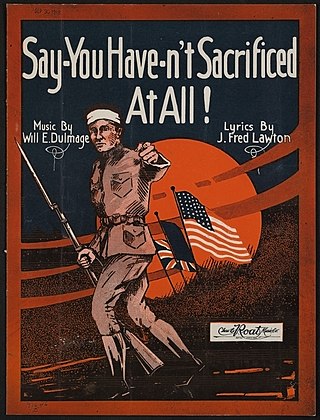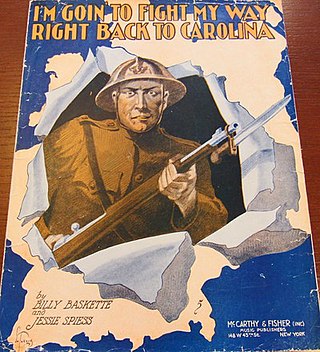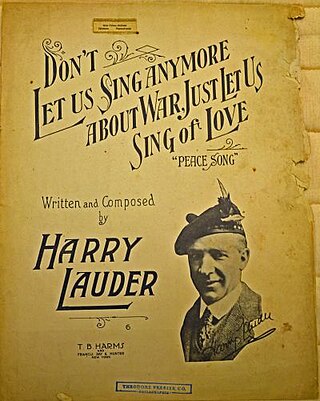
Berlin Bound is a World War I song written in 1918. The lyrics and music were written by James Kendis, James Brockman, and Nat Vincent. Kendis Brockman Music Co. published the song in New York, New York. On the cover of the sheet music is a drawing of soldiers dancing. The piece was written for both voice and piano.

"The Worst Is Yet to Come" is a World War I-era song recorded on December 12, 1918 in Camden, New Jersey. Sam M. Lewis and Joe Young provided the lyrics. Bert Grant was the composer. The song was published by Waterson, Berlin & Snyder, Inc. in New York City. Billy Murray performed the song. Artist Albert Wilfred Barbelle designed the cover art for the sheet music. On one version of the cover, a soldier is in position to bayonet a prisoner in bed.

Soldier Boy is a World War I era song released in 1915. D.A. Esrom wrote the lyrics. Theodore Morse composed the music. Leo Feist, Inc. of New York, New York published the song. Artist Harry Lewis designed the cover art for the sheet music. On the cover, there are three cartoon soldiers. One has his head turned to kiss a woman behind him. The song was written for both voice and piano. It is told from the point of view of a woman who is proud of her soldier boy. She addresses the soldier directly in the chorus:

A Mother's Prayer for Her Boy Out There is a World War I era song released in 1918. Andrew B. Sterling wrote the lyrics and Arthur Lange composed the music. It was written for voice and piano.

"Say, You Haven't Sacrificed at All! (March)", also written as "Say-You Haven't Sacrificed at All!" or "Say-You Have-n't Sacrificed at All!", is a World War I era song released in 1918. Most sources have attributed the role of composer to Will E. Dulmage and lyricist to J. Fred Lawton, as it is credited on the sheet music cover. One source has their roles reversed, and another source claims both composed the music. The song was published by Chas E. Roat Music Co. of Battle Creek, Michigan. On the cover is a soldier with a head wound, pointing. Behind him are British, French, and American flags. It was written for both voice and piano.

"My Sweetheart Is Somewhere in France" is a World War I era song first released in 1917. Mary Earl composed the music and wrote the lyrics. Shapiro, Bernstein & Co. Inc. of New York City published the song. Elizabeth Spencer performed a version of the song that was released by the Victor record label.

"I'm Goin' To Fight My Way Right Back to Carolina" is a World War I era song written and composed by Billy Baskette and Jessie Spiess. The song was published in 1918 by McCarthy & Fisher, Inc. of New York City. The sheet music cover was designed by Andre C. De Takacs. It features an armed soldier tearing through the cover. The song was written for both voice and piano.

"When the Sun Goes Down in Normandie " is a World War I era song released in 1918. Jeff Branen wrote the lyrics. Evans Lloyd composed the music. The song was published by Jeff Branen Publisher of New York, New York. The sheet music cover features a group of soldiers sitting around the camp fire. In the foreground is an armed soldier on guard duty walking through the campground. The song was written for both voice and piano.

"When the 'Yanks' Come Marching Home" is a World War I era song released in 1917. William Jerome wrote the lyrics. Seymour Furth composed the music. It was published by A.J. Stansy Music Co. of New York City.

"Lorraine " is a World War I era song released in 1917. Al Bryan wrote the lyrics. Fred Fisher composed the music. It was published by McCarthy and Fisher, Inc.. André De Takacs designed the sheet music cover. It features a French soldier with his bayonet drawn in the foreground. A woman, who is a symbol of Liberty, and child look on behind him. The song was written for voice and piano.

"Bring Back My Daddy To Me" is a World War I era song released in 1917. William Tracey and Howard Johnson wrote the lyrics. George W. Meyer composed the music. Leo Feist, Inc. of New York, New York published the song.

"And He'd Say, 'Oo-La-La! Wee-Wee!'" is a World War I era song released in 1919. Lyrics and music were written by George Jessel and Harry Ruby. William Baker arranged the song. It was published by Waterson, Berlin & Snyder, Inc. of New York, New York. The song was written for voice and piano.

"Girls of France" is a World War I era song released in 1917. Al Bryan and Edgar Leslie wrote the lyrics. Harry Ruby composed the music. The song was published by Waterson, Berlin & Snyder Co. of New York, New York. Artist Albert Wilfred Barbelle designed the sheet music cover. It features a nurse in the foreground, and soldiers marching behind her. It was written for both voice and piano.

"Don't Let Us Sing Anymore About War, Just Let Us Sing of Love " is a World War I era song released in 1918. Lyrics and music were written by Harry Lauder. It was published by T.B. Harms and Francis, Day & Hunter, Music Co. of New York, New York. The sheet music cover features a photo of Lauder with his autograph. The song was written for both voice and piano.
"Lafayette " is a World War I song written and composed by Mary Earl, which was a pseudonym of Robert A. King. It was published in New York, New York by Shapiro, Bernstein, & Co. in 1918. The sheet music cover, illustrated by Albert Barbelle, depicts soldiers marching with fixed bayonets below a statue of Lafayette in silhouette.

Don't Cry Frenchy, Don't Cry is a 1919 song written during World War I. The lyrics were written by Sam M. Lewis and Joe Young, and the music was written by Walter Donaldson.The song was published by Waterson, Berlin & Snyder Company in New York City.
"The Dixie Volunteers" is a World War I song written and composed by Edgar Leslie and Harry Ruby. This song was published in 1917 by Waterson, Berlin & Snyder Co., in New York, NY.The sheet music cover, illustrated by Barbelle, features soldiers marching with an inset photo of Eddie Cantor.

Let's All Be Americans Now is a World War I song written and composed by Irving Berlin, Edgar Leslie, and George W. Meyer. The song was first published in 1917 by Waterson, Berlin & Snyder Co., in New York, NY.The sheet music cover depicts a soldier with his rifle and silhouetted marching soldiers in the background. A popular recording in 1917 was made by the American Quartet.
We'll Knock The Heligo—Into Heligo—Out Of Heligoland! is a World War I song written by John J. O'Brian and composed by Theodore Morse. The song was first published in 1917 by Leo Feist Inc., in New York, NY. The sheet music cover depicts a terrified Kaiser standing on a cliff with a city below and United States soldiers rushing toward him.
When the Flowers Bloom On No-Man's Land is a World War I song written by Howard E. Rogers and composed by Archie Gottler. The song was first published in 1918 by Kalmar, Puck, & Abrahams Music Co., in New York, NY. The sheet music cover depicts soldiers marching with an inset photo of Fred Weber. The sheet music was later reprinted with an inset photo of Dorothy Jarrett.
















